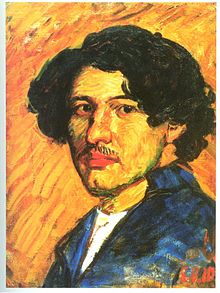Dimitri Shevardnadze
დიმიტრი შევარდნაძე Dimitri Shevardnadze | |
|---|---|
 | |
| Born | December 1, 1885 |
| Died | 1937 |
| Nationality | Georgian |
| Known for | painting |
Dimitri Shevardnadze (Georgian: დიმიტრი შევარდნაძე) (December 1, 1885 – 1937) was a Georgian painter, art collector and intellectual purged during Joseph Stalin's repressions.
Life
Born in Bakhvi, a small village in the western Georgian province of Guria, then part of the Russian Empire, he was educated at the art academies of St Petersburg and Munich. Upon his return to Georgia, he founded, in 1916, and led the Association of Georgian Artists. He helped also to establish the National Gallery of Fine Arts (1920) and the Tbilisi State Academy of Arts (1922). He decorated several opera and theatre performances, and movies, and designed an official logo of the Tbilisi State University.

Revolt
In 1937, the Communist chief of Georgia, Lavrentiy Beria, intended to destroy the medieval Metekhi church in Tbilisi, but met stubborn opposition from a group of Georgian intellectuals led by Dimitri Shevardnadze. Beria replied to their urges, that it would surely be enough to preserve a scale model of the church so that people could see it in a museum, and then told Shevardnadze privately that if he gave up his efforts to save the church he would be appointed director of the future museum. The artist refused and was eventually imprisoned and executed. The church was preserved, however.[1]
Family
Georgian politician Eduard Shevardnadze was a son of a cousin of Dmitri Shevardnadze.[2]
References
- ^ Ami Knight (1993), Beria: Stalin’s First Lieutenant, page 84. Princeton University Press, ISBN 0-691-01093-5
- ^ "ШЕВАРДНАДЗЕ: БЕРИЯ УБИЛ СТАЛИНА И РАССТРЕЛЯЛ ДВОЮРОДНОГО БРАТА МОЕГО ОТЦА". 22 March 2010. Archived from the original on April 6, 2012. Retrieved September 27, 2011.
